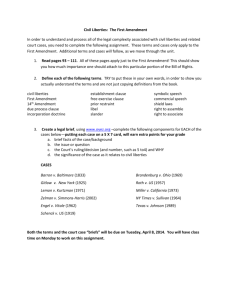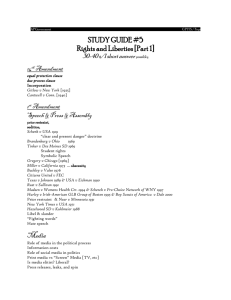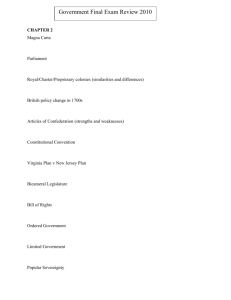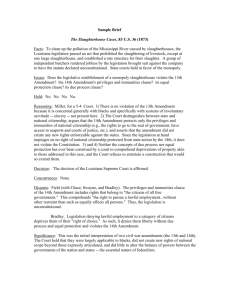File
advertisement
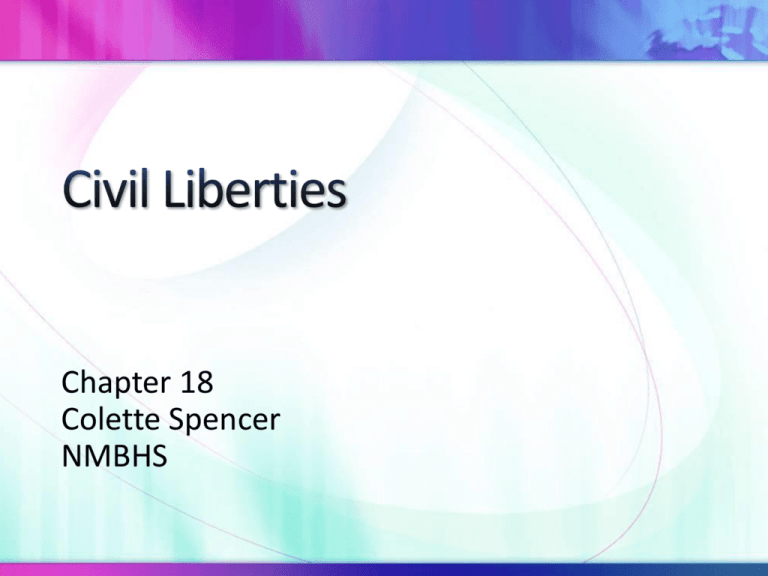
Chapter 18 Colette Spencer NMBHS Civil liberties protect people from the abuses of government Civil rights come about as a result of the equal protection under the law However, both limit the power of gov’t Civil liberties are guaranteed in the Constitution, the Bill of Rights, other amendments and through court interpretation The Constitution guarantees many “civil rights”: Writ of habeas corpus – informed of charges No bills of attainder – can’t be punished w/o trial Freedom of religion, press, speech, petition, and assembly No unreasonable search and seizure Protection against selfincrimination and double jeopardy Protections in criminal proceedings 14th Amendment expanded individual rights Supreme Court interpreted the due process clause to apply to state and local gov’ts also Congress passes laws that set limits on one person’s rights over another or balance rights of people with the interests of society Example: false advertising not protected under 1st Amendment Federal court decisions protect rights through judicial review Two protections exist for freedom of religion: establishment clause and free exercise clause “Congress shall make no law respecting an establishment of religion, or prohibiting the free exercise thereof” Establishment Clause: No national religion Can’t favor one over the other Can’t tax to support a religion The Supreme Court has helped define the parameters of this clause: Engel v. Vitale – 1962 – school sanctioned prayer is unconstitutional Abington School District v. Schempp – 1963 – no required reading of the Bible at the beginning of each day Lemon v. Kurtzman – 1971 – struck down law reimbursing parochial schools for textbooks and salaries. Also established the Lemon Test: A law must: 1) have a primarily secular purpose 2) its principal effect must not aid or inhibit religion 3) it must not create excessive entanglement between government and religion Lynch v. Donnelly – 1984 – upheld the right of gov’ts to celebrate Christmas with displays as long as secular displays were included Edwards v. Aguillard – 1987 – Louisiana could not force public schools that taught evolution to also teach creationism Santa Fe Independent School District v. Doe – 2002 – overturned Texas law that allowed high school students to read a prayer at athletic events like football games Free Exercise Clause: Guarantees the right to practice any religion or no religion Courts have said that the practice of beliefs may be restricted, esp. if they conflict with criminal law Reynolds v. US – 1879 – upheld federal law that prohibited polygamy Wisconsin v. Yoder – 1972 – ruled that Wisconsin could not require Amish children to go beyond the 8th grade due to beliefs Employment Division of Oregon v. Smith – 1990 – ruled that Oregon could deny unemployment benefits to workers fired for using drugs (peyote) as part of a religious ceremony Different types: Pure speech – most common, verbal, given most protection by courts Speech plus – verbal and symbolic speech used together, like at a rally and then picketing; may be limited Symbolic speech – using actions or symbols to convey ideas, like burning a draft card or flag; may be restricted if it endangers the public Limits on free speech usually exist in the area of providing for national security 1798 – Alien and Sedition Acts first laws that limited free speech – expired in 1801 After the assassination of McKinley in 1901 and then WWI, the gov’t again began passing laws limiting speech: Schenck v. US – 1919 – he mailed fliers to draftees during WWI to urge them to protest peacefully, convicted of encouraging disobedience of military orders; this speech not protected during wartime Gitlow v. New York – 1925 – Gitlow convicted in NY of advocating the forcible overthrow of the gov’t using violent means - courts applied protection of free speech to the states under the due process clause of the 14th Amendment Tinker v. Des Moines – 1969 – court ruled that wearing black armbands protesting the Vietnam War was symbolic and protected by 1st Amendment Brandenburg v. Ohio – 1969 – Court made the “clear and present” danger test less restrictive by saying that using inflammatory speech could be punished only if there was imminent danger that the speech would incite an illegal act. Miller v. California – 1973 – Court established the Miller test setting standards for defining obscenity: 1) theme appeals to indecent sexual desires by applying contemporary standards 2) show in a clearly offensive way behavior outlawed by state law 3) lacks serious literary, artistic, political, or scientific value Texas v. Johnson (1989) – Flag burning is a protected form of symbolic speech Since 1940’s, Court has supported the following: 1st Amendment freedoms are more important than other freedoms because they provide a basis for those freedoms Closely related to freedom of speech Basic interpretation comes down to: protecting a person’s right to free speech vs. gov’t limiting it to protect the interests and safety of the country Near v. Minnesota (1931) – Court applied the protections of free press to the states under the “due process” clause of 14th Amendment New York Times v. Sullivan (1964) – protected statements about public officials Defined what constitutes libel New York Times v. US (1971) – using prior restrain, the Court refused to stop the publication of the Pentagon Papers Applies to both public and private places Citizens can make their views known through petitions, letters, picketing, demonstrations, parades and marches. Court has allowed the gov’t to set limits to protect rights and safety of others Dejonge v. Oregon (1937) – said right of assembly was as important as other 1st Amendment rights DeJonge had right to organize a Communist Party and speak at meetings even though it advocated revolution Dennis V. US (1951) – fear of Communism at the time resulted in upholding that Dennis had violated the Smith Act by advocating the forcible overthrow of the gov’t Also used “due process” clause to apply it to states Courts have generally ruled: Gov’t may require groups to obtain a permit before marches or demonstrations Certain facilities (jails, schools, airports) may be restricted from demonstrations Restrictions must apply to all groups equally Does not allow groups to use private property for its own use (buffer zone around abortion clinics) Police may disperse group to keep the peace or protect safety of others if demonstration become violent Private property is protected by the “due process” clause of 5th and 14th Amendments Due process = gov’t acting in a fair manner according to established rules 5th Amendment says gov’t can’t take property without paying a fair price for it Eminent domain = gov’t can take property for public use but must give fair compensation for it Constitution does not mention “right to privacy” But Court has mentioned it Griswold v. Connecticut (1965) – 1st, 3rd, 4th, 9th and 14th Amendments created “zones of privacy” and enhanced concept of enumerated rights Roe v. Wade (1973) – constitutional right of privacy for a women to determine whether to terminate a pregnancy Planned Parenthood v. Casey (1992) – minors must wait 24 hours after getting parental permission to have an abortion – also women do not have to inform spouses 4th, 5th, 6th, 8th Amendments and 14th Amendment to apply it to states 4th Amendment: Search and Seizure Mapp v. Ohio (1961) – evidence obtained without a search warrant was excluded from trial in state courts – used “exclusionary rule” Terry v. Ohio (1968) – searches of criminal suspects for safety purposes are okay Nix v. Williams (1984) – “inevitable discovery rule” – evidence from an illegal search can be introduced if it can be shown that it would have been found anyway 5th Amendment: Self-Incrimination Miranda v. Arizona (1966) – suspects in police custody have rights and they must be informed of those rights. 6th Amendment: Right to an Attorney Powell v. Alabama (1932) – “due process clause” of 14th Amendment guarantees death penalty defendants the right to an attorney Betts v. Brady (1963) – poor defendants in noncapital cases are not entitled to an attorney at the state’s expense Gideon v. Wainwright (1963) – in state trials, people who can’t afford an attorney will be provided one by the state Overturned Betts. v. Brady Escobedo v. Illinois (1964) – extended exclusionary rule to confessions in state court cases “Escobedo Rule” – people have a right to an attorney when the investigation begins 8th Amendment: Cruel & Unusual Punishment Furman v. Georgia (1972) – death penalty unconstitutional under existing state law because it was imposed arbitrarily Gregg v. Georgia (1976) – death penalty constitutional because it was imposed based on circumstances of the case 9th Amendment called “elastic clause” of the Bill of Rights 10th Amendment is the basis for federalism US v. Lopez (1995) – ruled that the Gun-Free School Zone Safety Act which made possession of a gun within 1000 yards of a school a federal crime unconstitutional


